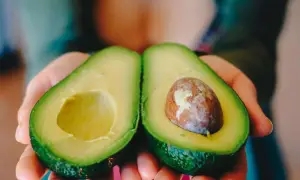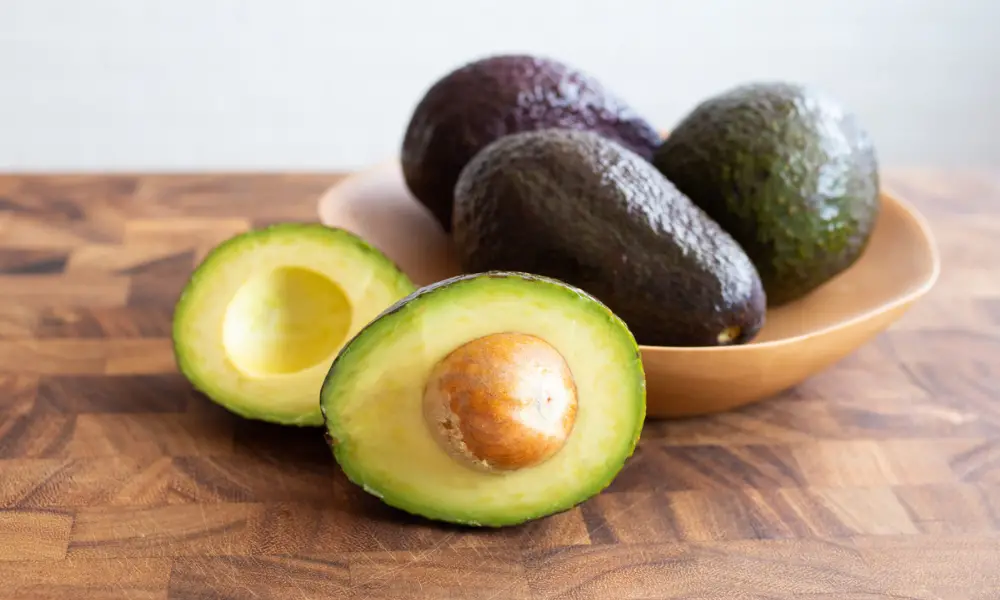One should avoid putting avocados in the refrigerator first for their health concerns. They won’t fully mature if they are refrigerated before they should. Like bananas, when avocados are picked from the tree, ethylene is released, which starts the ripening process. Storage works best in a cool, dark location with a temperature of 68 F.
Under these circumstances, recently harvested avocados should ripen in a few days. When an avocado is ripe, you should slightly squeeze an avocado to give pressure. To preserve and store avocados, follow these simple steps.

How to Store Cut Avocados?
Sometimes, half of an avocado will do (for avocado toast or as a salad topping), and throwing away this precious green fruit is not an option. Online avocado savers are available, but there are more quick ways to store chopped avocados in a pinch.
Skin-On
Don’t remove the avocado flesh just yet, if you haven’t. If you can, keep the pit unbroken and leave it in the skin. The skin and pit limit the amount of visible flesh and eventually become dark because they prevent oxygen from reaching the flesh.
Place plastic wrap directly on the flesh to prevent air from touching it and put it in the refrigerator to help preserve the remaining portions. At least two days should pass before it becomes brown.
With an Onion in Storage
You can store your avocado half with a sliced onion in an airtight jar in the refrigerator. The onion’s fumes slow down the browning process. Your avocado will continue to be green for at least two days, although it might taste like onions. Depending on the use you intend for it, that might be advantageous.
Skin-Off
It’s ok if you’ve already removed the avocado flesh; you can still keep it from going bad. Mash an avocado and pour it into a non-reactive container. Next, lay a piece of plastic wrap directly on the avocado, ensuring no air bubbles, rather than covering the container with a lid. Your avocado should stay green for at least two days in the refrigerator, just like in the skin-on situation. You can include an acid, such as lemon or lime juice, to slow the process further. Additionally, scraping off the top layer should reveal green avocado, even if the combination appears brown.
Long-Term Storage of Avocados
It’s time to think outside the box if you want to use your chopped avocados for more than just a few extra days. Pickling it is one way to preserve it, and you can pickle just about anything, which may sound absurd. Slices of pickled avocado are good atop sandwiches and as a standalone snack. They and they so be frozen. We’ve put together this simple guide to help you understand how to freeze avocados and use them.
How to Store Whole Avocados?
Avocados ought to be kept out on the counter so they can ripen naturally in the ambient air. Avoid putting avocados in paper bags while storing them because doing so would trap the fruit’s ethylene gas and hasten the ripening process. (Unsure if your avocado is ready to eat? Find out how to determine whether an avocado is ripe.)
The refrigerator is the greatest location to keep entire avocados you aren’t quite ready to consume.
The ripening process is slowed down by refrigeration. A ripe or almost ripe avocado should be kept in the refrigerator. The texture and flavor can suffer when unripe avocados mature in the refrigerator. If your avocado is ripe, store it whole and uncut in the refrigerator’s fruit drawer or an airtight container. It should be edible for around two weeks, depending on how ripe it was when you put it in.
What are the Ways to Preserve Avocados that Dispel Myths?
There are many suggestions for storing avocados on the internet, but they rarely turn out to be very effective. To name a few:
Keeping them in Olive Oil
Some claim that covering your avocado in a thin layer of olive oil will prevent it from turning brown for one or two days. The oil is supposed to act as a barrier to oxygen to prevent oxidation and browning. Using a lot of oil can buy you a little time, but your avocado will turn brown before the day is through.
Shock & Blanch
This procedure includes submerging a whole avocado (skin on) for 10 seconds in hot water before submerging it again in icy water. While it might temporarily prevent browning, the taste and texture are enough altered that the effort is not worthwhile.
Avocado Mash & the Pit
Ever find an avocado pit in a guacamole bowl? Some individuals believe that placing a pit in a bowl of guacamole will prevent browning.
While the pit can stop an avocado from browning when it is cut (by preventing oxygen from getting to the flesh below it), it is not a panacea. Your guacamole will not stay green if you add the pit to it.
What is the Cause of Avocado Browning?
You might have observed that any avocado left over quickly turns from green to brown unless you consume it as soon as you come home from the grocery shop. Although a little brown avocado doesn’t taste all that different from a fresh-cut avocado’s vivid, dark green color, getting a scoop of brown guacamole on a tortilla chip is unpleasant. The brown color is oxidation, affecting apples and potatoes when exposed to oxygen. All three undergo practically instantaneous change, but apples and potatoes can avoid oxidation by being immersed in water. There are techniques to delay the process, but sadly, it is not a solution for avocados.
How can you Tell When an Avocado is Ripe?
The characteristic of all varieties of avocados is that they yield when you gently crush them between your palms. Though it shouldn’t feel soft, there should be some give. The skin of a Hass avocado should be purple-brown rather than green. Since other avocado cultivars remain green, the hue isn’t all that useful.
If you need the fruit in a few days, buy firm avocados; if you need them right away, consider avocados with some give.
Avoid avocados that are soft as the flesh may have some brown patches. My experience has taught me not to purchase avocados with the stem (top cap) peeled back. The avocados without stems were nearly all, if not all, largely brown inside.
How to Recognize a Bad Avocado?
Throw away an avocado if:
It feels mushy or is incredibly soft to the touch. If a light press results in an indentation on the fruit’s skin, it is overripe. The same applies if you think it’s soft in a disgusting way.
It is filled with threads or dense fibers, which are more frequently found in fruit from younger trees or due to poor storage practices. Although the fibers are acceptable to consume, I believe they detract from the avocado-eating experience. For fruit quality reasons, it’s acceptable to throw away the fruit if you discover those within.
The majority of the flesh is black or brown. Although it’s better to avoid eating damaged brown or black flesh unless it makes up most of the fruit, you can still cut it out. One exception to this rule: avocado flesh quickly turns brown when exposed to air, so if your avocado half had been stored in the refrigerator for a day, it would already be brown.
It is rotten. After keeping the fruit in the fridge for a few days, it should be discarded if you observe any white or grey fuzz on the exterior or, more likely, on the flesh.
It has a sour or rotten odor. Eating avocado under one of these conditions is not a good idea.
The taste is strange. Fruit must be discarded if the flavor makes you think of certain substances or if it just tastes bad.
Toss the avocado out of caution if anything else that doesn’t seem right emerges on your radar. Safer to be safe than sorry.
Avocados: How Long do they Last?
It takes an unripe avocado between two and five days to become edible. After maturing, it can be stored in the refrigerator for an additional 3 to 5 days at its best. After that, the fruit reaches an overripe state and develops brown blotches over time.
In the refrigerator, cut or mashed avocado can stay fresh for up to 3 to 4 days.
The meat will quickly turn brown if you don’t spritz it with something acidic like lemon juice. While the browned flesh isn’t unpleasant, it doesn’t look good in guacamole or avocado toast.
Why should you Not Eat Avocado?
Consuming avocado frequently throughout the day or adding it to foods that already include lipids might easily result in consuming more calories and fat grams than you realize. Even if the extra calories are healthy, your body will retain them as fat if you consume more daily than it expels.
Your calorie intake can influence your risk of developing type 2 diabetes, coronary heart disease, and obesity. Three hundred twenty-two calories are present in a typical avocado. To put that into perspective, a McDonald’s cheeseburger has more calories.
Furthermore, if you use guacamole to eat your avocado, be aware that you can consume more than one avocado and up to 200 calories worth of fried tortilla chips.
Ilana Muhlstein, RD, a dietitian-nutritionist and the author of You Can Drop It!, claims that consuming “good foods” can also become unhealthy if you consume too much of them. The Way I Lost 100 Pounds Having Chocolate, Cocktails, and Carbs—And You Can Too! She claims, “Up until I realized that sushi contains the carb equivalent of many slices of bread, I always felt sushi was a good choice.
Hypersensitivity to Avocado
Hypersensitive people should not consume avocados, as it could result in a skin response or nausea.
Allergy to Avocado
Avocado consumption can have negative repercussions, with severe skin problems and allergies being the main ones. Hives, itching, skin redness, and eczema are signs of an allergic reaction.
Liver Damage
Avocados can seriously harm the liver’s health, one of its harmful side effects. Several varieties of avocado oil can harm your liver. Avoid Mexican avocado, which contains anethole and estragole. The potential for these components to cause cancer has been investigated, and consuming them could harm the liver. Avoid avocado oil if you have liver disease, and stop eating this fruit to prevent negative consequences.
Can Stringy Avocado be Eaten?
YES! It is acceptable to consume a stringy avocado, and I will demonstrate how still to enjoy your avocado in the following simple step. The outcome is meat that is smooth and creamy and may be used in a variety of ways. There are also a few recipe suggestions below.
The good news in this story is that. There is no need to discard the flesh if it is still green and has not turned brown. This avocado probably cost you quite a bit of coin, so the last thing you want to do is throw away your hard-earned cash.
Conclusion
Bananas and plums (find out how long plums last here) may be stored in much the same way as avocados. Your avocado should be kept in a dry area at room temperature or a little lower as long as it is still unripe, and it can be done in the kitchen cabinet or pantry.
Unripe avocados shouldn’t be kept in the refrigerator since they won’t be able to ripen, will stay very solid, and won’t develop their best flavor profile. Keeping it at room temperature is a major concern.
